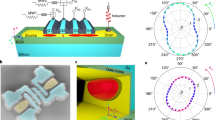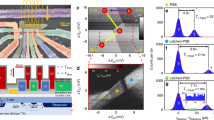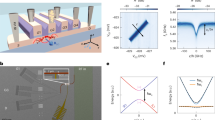Abstract
Electron-spin qubits have long coherence times suitable for quantum technologies. Spin–orbit coupling promises to greatly improve spin qubit scalability and functionality, allowing qubit coupling via photons, phonons or mutual capacitances, and enabling the realization of engineered hybrid and topological quantum systems. However, despite much recent interest, results to date have yielded short coherence times (from 0.1 to 1 μs). Here we demonstrate ultra-long coherence times of 10 ms for holes where spin–orbit coupling yields quantized total angular momentum. We focus on holes bound to boron acceptors in bulk silicon 28, whose wavefunction symmetry can be controlled through crystal strain, allowing direct control over the longitudinal electric dipole that causes decoherence. The results rival the best electron-spin qubits and are 104 to 105 longer than previous spin–orbit qubits. These results open a pathway to develop new artificial quantum systems and to improve the functionality and scalability of spin-based quantum technologies.
This is a preview of subscription content, access via your institution
Access options
Access Nature and 54 other Nature Portfolio journals
Get Nature+, our best-value online-access subscription
$29.99 / 30 days
cancel any time
Subscribe to this journal
Receive 12 print issues and online access
$259.00 per year
only $21.58 per issue
Buy this article
- Purchase on Springer Link
- Instant access to full article PDF
Prices may be subject to local taxes which are calculated during checkout




Similar content being viewed by others
Data availability
The data represented in Figs. 1–4 are provided with the paper as source data. All other data that support results in this Article are available from the corresponding author upon reasonable request. Source data are provided with this paper.
Code availability
The custom codes that were used for drawing energy level diagrams and fitting are available from the corresponding author upon reasonable request.
References
Tyryshkin, A. M. et al. Electron spin coherence exceeding seconds in high-purity silicon. Nat. Mater. 11, 143–147 (2012).
Muhonen, J. T. et al. Storing quantum information for 30 seconds in a nanoelectronic device. Nat. Nanotechnol. 9, 986–991 (2014).
Veldhorst, M. et al. An addressable quantum dot qubit with fault-tolerant control-fidelity. Nat. Nanotechnol. 9, 981–985 (2014).
Bar-Gill, N., Pham, L. M., Jarmola, A., Budker, D. & Walsworth, R. L. Solid-state electronic spin coherence time approaching one second. Nat. Commun. 4, 1743 (2013).
Bulaev, D. V. & Loss, D. Spin relaxation and decoherence of holes in quantum dots. Phys. Rev. Lett. 95, 076805 (2005).
Xiang, Z.-L., Ashhab, S., You, J. Q. & Nori, F. Hybrid quantum circuits: superconducting circuits interacting with other quantum systems. Rev. Mod. Phys. 85, 623–653 (2013).
Mi, X. et al. A coherent spin–photon interface in silicon. Nature 555, 509–603 (2018).
Kato, Y. K., Myers, R. C., Gossard, A. C. & Awschalom, D. D. Observation of the spin Hall effect in semiconductors. Science 306, 1910–1913 (2004).
Georgescu, I. M., Ashhab, S. & Nori, F. Quantum simulation. Rev. Mod. Phys. 86, 153–185 (2014).
Sau, J. D., Lutchyn, R. M., Tewari, S. & das Sarma, S. Generic new platform for topological quantum computation using semiconductor heterostructures. Phys. Rev. Lett. 104, 040502 (2010).
Nadj-Perge, S., Frolov, S. M., Bakkers, E. P. A. M. & Kouwenhoven, L. P. Spin orbit qubit in a semiconductor nanowire. Nature 468, 1084–1087 (2010).
de Greve, K. et al. Ultrafast coherent control and suppressed nuclear feedback of a single quantum dot hole qubit. Nat. Phys. 7, 872–878 (2011).
Song, Y. P. & Golding, B. Manipulation and decoherence of acceptor states in silicon. Europhys. Lett. 95, 47004 (2011).
Maurand, R. et al. A CMOS silicon spin qubit. Nat. Commun. 7, 13575 (2016).
Watzinger, H. et al. A germanium hole spin qubit. Nat. Commun. 9, 3902 (2018).
Hendrickx, N. W., Franke, D. P., Sammak, A., Scappucci, G. & Veldhorst, M. Fast two-qubit logic with holes in germanium. Nature 577, 487–491 (2020).
Luttinger, J. M. & Kohn, W. Motion of electrons and holes in perturbed periodic fields. Phys. Rev. 97, 869–883 (1955).
Beaudoin, F., Lachance-Quirion, D., Coish, W. A. & Pioro-Ladrìere, M. Coupling a single electron spin to a microwave resonator: controlling transverse and longitudinal couplings. Nanotechnology 27, 464003 (2016).
Lambert, N. et al. Amplified and tunable transverse and longitudinal spin-photon coupling in hybrid circuit-QED. Phys. Rev. B 97, 125429 (2018).
Winkler, R. Spin density matrix of spin-3/2 hole systems. Phys. Rev. B 70, 125301 (2004).
Kim, D. et al. Quantum control and process tomography of a semiconductor quantum dot hybrid qubit. Nature 511, 70–74 (2014).
Kawakami, E. et al. Electrical control of a long-lived spin qubit in a Si/SiGe quantum dot. Nat. Nanotechnol. 9, 666–670 (2014).
Yoneda, J. et al. A quantum-dot spin qubit with coherence limited by charge noise and fidelity higher than 99.9%. Nat. Nanotechnol. 13, 102–106 (2018).
Zajac, D. M. et al. Resonantly driven CNOT gate for electron spins. Science 359, 439–442 (2018).
Salfi, J., Mol, J. A., Culcer, D. & Rogge, S. Charge-insensitive single-atom spin-orbit qubit in silicon. Phys. Rev. Lett. 116, 246801 (2016).
van der Heijden, J. et al. Probing the spin states of a single acceptor atom. Nano Lett. 14, 1492–1496 (2014).
van der Heijden, J. et al. Readout and control of the spin-orbit states of two coupled acceptor atoms in a silicon transistor. Sci. Adv. 4, eaat9199 (2018).
Neubrand, H. ESR from boron in silicon at zero and small external stress I. Line positions and line structure. Phys. Status Solidi B 86, 269–275 (1978).
Stegner, A. R. et al. Isotope effect on electron paramagnetic resonance of boron acceptors in silicon. Phys. Rev. B 82, 115213 (2010).
Dirksen, P., Henstra, A. & Wenckebach, W. T. An ESR hole burning study of dynamic nuclear polarisation of 29Si in Si:B. J. Phys. Condens. Matter 1, 8535–8541 (1989).
Ruskov, R. & Tahan, C. On-chip cavity quantum phonodynamics with an acceptor qubit in silicon. Phys. Rev. B 88, 064308 (2013).
Feher, G., Hensel, J. C. & Gere, E. A. Paramagnetic resonance absorption from acceptors in silicon. Phys. Rev. Lett. 5, 309–311 (1960).
Mims, W. B. Phase memory in electron spin echoes, lattice relaxation effects in CaWO4: Er, Ce, Mn. Phys. Rev. 168, 370–389 (1968).
Abadillo-Uriel, J. C. et al. Entanglement control and magic angles for acceptor qubits in Si. Appl. Phys. Lett. 113, 012102 (2018).
Köpf, A. & Lassmann, K. Linear Stark and nonlinear Zeeman coupling to the ground state of effective mass acceptors in silicon. Phys. Rev. Lett. 69, 1580–1583 (1992).
Bir, G., Butekov, E. & Pikus, G. Spin and combined resonance on acceptor centres in Ge and Si type crystals—I: paramagnetic resonance in strained and unstrained crystals. J. Phys. Chem. Solids 24, 1467–1474 (1963).
Bir, G., Butikov, E. & Pikus, G. Spin and combined resonance on acceptor centres in Ge and Si type crystals—II: the effect of the electrical field and relaxation time. J. Phys. Chem. Solids 24, 1475–1486 (1963).
Landau, L. D. & Lifshitz, E. M. Quantum Mechanics: Non-Relativistic Theory (Pergamon, 1981).
White, G. K. Thermal expansion of reference materials: copper, silica and silicon. J. Phys. D Appl. Phys. 6, 2070–2078 (1973).
Acknowledgements
This work was supported by the ARC Centre of Excellence for Quantum Computation and Communication Technology (CE170100012), in part by the US Army Research Office (W911NF-08-1-0527). T.K. acknowledges support from the Tohoku University Graduate Program in Spintronics. J.S. acknowledges support from an ARC DECRA fellowship (DE160101490). M.Y.S. acknowledges a Laureate Fellowship. We thank M. Thewalt for the 28Si sample.
Author information
Authors and Affiliations
Contributions
T.K., J.S. and S.R. designed the experiment. T.K. carried out the experiments (except for X-ray diffraction) and analysed the data, with input from J.S., J.v.d.H., C.C., B.C.J., J.C.M. and S.R.; T.K., J.S. and D.C. carried out the theory calculations. T.K. and J.S. performed the numerical simulation of the strain distribution. W.D.H. carried out the X-ray diffraction analyses. H.R., N.A., P.B. and H.-J.P. supplied the boron-doped 28Si crystal. All authors discussed the results. T.K. wrote the manuscript with contributions from all authors.
Corresponding authors
Ethics declarations
Competing interests
The authors declare no competing interests.
Additional information
Publisher’s note Springer Nature remains neutral with regard to jurisdictional claims in published maps and institutional affiliations.
Supplementary information
Supplementary Information
Supplementary Figs. 1–7 and discussions.
Source data
Source Data Fig. 1
Numerical data used to generate Fig. 1a,b.
Source Data Fig. 2
Numerical data used to generate Fig. 2b,c.
Source Data Fig. 3
Numerical data used to generate Fig. 3.
Source Data Fig. 4
Numerical data used to generate Fig. 4.
Rights and permissions
About this article
Cite this article
Kobayashi, T., Salfi, J., Chua, C. et al. Engineering long spin coherence times of spin–orbit qubits in silicon. Nat. Mater. 20, 38–42 (2021). https://doi.org/10.1038/s41563-020-0743-3
Received:
Accepted:
Published:
Issue Date:
DOI: https://doi.org/10.1038/s41563-020-0743-3
This article is cited by
-
Review of performance metrics of spin qubits in gated semiconducting nanostructures
Nature Reviews Physics (2022)
-
Devitalizing noise-driven instability of entangling logic in silicon devices with bias controls
Scientific Reports (2022)
-
Semiconductor qubits in practice
Nature Reviews Physics (2021)
-
Optimal operation points for ultrafast, highly coherent Ge hole spin-orbit qubits
npj Quantum Information (2021)



